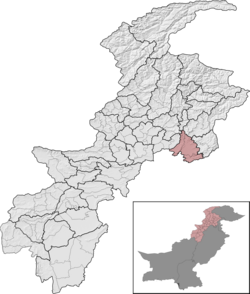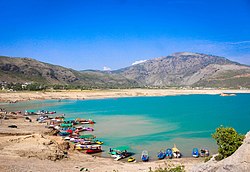Haripur District (Hindko, Urdu: ضلع ہری پور) is a district in the Hazara Division of Khyber Pakhtunkhwa, Pakistan. Before obtaining the status of a district in 1991, Haripur was a tehsil of Abbottabad District Its headquarters are the city of Haripur. According to 2023 Pakistani census population of Haripur District is 1,173,056 (1.1 million).
Haripur District
ضلع ہری پور | |
|---|---|
Top: Khanpur Dam Bottom: Buddhist remains at Badalpur | |
 Haripur District (red) in Khyber Pakhtunkhwa | |
| Country | |
| Province | |
| Division | Hazara Division |
| Established | 1991 |
| Preceded | Abbottabad District (1853-1991) |
| Headquarters | Haripur |
| Administrative Tehsils | 03
|
| Government | |
| • Type | District Administration |
| • Deputy Commissioner | Shauzab Abbas |
| • Constituensy | NA-18 Haripur |
| Area | |
| • District of Khyber Pakhtunkhwa | 1,725 km2 (666 sq mi) |
| Elevation | 691 m (2,267 ft) |
| Highest elevation | 1,711 m (5,614 ft) |
| Lowest elevation | 416 m (1,365 ft) |
| Population (2023)[1] | |
| • District of Khyber Pakhtunkhwa | 1,173,056 |
| • Density | 680/km2 (1,800/sq mi) |
| • Urban | 147,765 |
| • Rural | 1,027,018 |
| Demonym | Karachiite |
| Time zone | UTC+05:00 (PKT) |
| • Summer (DST) | DST is not observed |
| ZIP Code | |
| NWD (area) code | 0995 |
| ISO 3166 code | PK-KP |
| CNIC Code of Haripur District | 1330X-XXXXXXX-X |
| Website | haripur |
Geography
editGeographically, the district borders the Abbottabad District to the northeast, Mansehra District to the northeast, the Punjab to the southeast, the Buner to the northwest, and Swabi to the west. The federal capital of Islamabad is adjacent to the district in the south.
Demographics
edit| Year | Pop. | ±% p.a. |
|---|---|---|
| 1951 | 252,168 | — |
| 1961 | 273,507 | +0.82% |
| 1972 | 417,561 | +3.92% |
| 1981 | 479,031 | +1.54% |
| 1998 | 692,228 | +2.19% |
| 2017 | 1,001,515 | +1.96% |
| 2023 | 1,174,783 | +2.70% |
| Sources:[2] | ||
As of the 2023 census, Haripur district has 192,451 households and a population of 1,174,783. The district has a sex ratio of 101.43 males to 100 females and a literacy rate of 74.88%: 84.13% for males and 65.61% for females. 282,230 (24.06% of the surveyed population) are under 10 years of age. 147,765 (12.58%) live in urban areas.[1]
Religion
edit| Religion | 1941[3]: 22 [a] | 2017[4] | 2023[5] | |||
|---|---|---|---|---|---|---|
| Pop. | % | Pop. | % | Pop. | % | |
| Islam | 178,545 | 95.04% | 1,000,322 | 99.88% | 1,169,155 | 99.67% |
| Hinduism | 7,278 | 3.87% | 13 | ~0% | 50 | 0.01% |
| Sikhism | 2,011 | 1.07% | — | — | 22 | ~0% |
| Christianity | 14 | 0.01% | 829 | 0.08% | 3,570 | 0.30% |
| Other | 6 | 0.01% | 351 | 0.04% | 259 | 0.02% |
| Total Population | 187,854 | 100% | 1,001,515 | 100% | 1,173,056[b] | 100% |
Languages
editAt the time of the 2023 census, 942,172 of the population spoke Hindko, 172,471 spoke Pashto, 23,423 Urdu, and 11,854 Punjabi and 23,136 others as their first language.[6]
Administration
editThe district of Haripur was a tehsil (sub-division) of the Abbottabad District until 1992. After that, it received the status of an independent district.[7] Currently, Haripur District is divided into three Tehsils:
- Haripur Tehsil (Urdu: تحصیل ہری پور)[8]
- Khanpur Tehsil (Urdu: تحصیل خانپور)
- Ghazi Tehsil (Urdu: تحصیل غازی) [9][8] There were 30 Union Councils in 1962 and in 1979 , 25 UC were reconstituted.
Provincial Assembly
edit| Member of Provincial Assembly | Party Affiliation | Constituency | Year |
|---|---|---|---|
| Akbar Ayub Khan | Pakistan Tehreek-e-Insaf | PK-40 Haripur-I | 2024 |
| Arshad Ayub Khan | Pakistan Tehreek-e-Insaf | PK-41 Haripur-II | 2024 |
| Umer Ayub Khan | Pakistan Tehreek-e-Insaf | NA-18 Haripur | 2024 |
| Adeel Iqbal | Pakistan Tehreek-e-Insaf | PK-42 Haripur-III | 2024 |
Education
editHaripur District has two government-funded postgraduate colleges, providing higher-level education, as well as four-degree colleges for women. The Haripur University was established in 2012, which was initially a Haripur campus (established in March 2008) of the Hazara University .The campus was upgraded to a full-fledged University of Haripur (UoH) in 2012 by the Government of Khyber Pakhtunkhwa.[10][11]
In addition, the project of the Pak-Austria Fachhochschule Institute of Applied Sciences and Technology has also been functioning and is providing higher education since 2017 in village Mang at the main Khanpur Road in Haripur.
See also
editReferences
edit- ^ a b "7th Population and Housing Census - Detailed Results: Table 1" (PDF). www.pbscensus.gov.pk. Pakistan Bureau of Statistics.
- ^ "Population by administrative units 1951-1998" (PDF). Pakistan Bureau of Statistics.
- ^ "Census of India, 1941. Vol. 10, North-West Frontier Province". 1941. p. 22. JSTOR saoa.crl.28215543. Retrieved 23 September 2021.
- ^ "Pakistan Census 2017 District-Wise Tables: Haripur District". Pakistan Bureau of Statistics.
- ^ "7th Population and Housing Census - Detailed Results: Table 9" (PDF). www.pbscensus.gov.pk. Pakistan Bureau of Statistics.
- ^ a b "7th Population and Housing Census - Detailed Results: Table 11" (PDF). Pakistan Bureau of Statistics.
- ^ 1998 District Census report of Haripur. Census publication. Vol. 91. Islamabad: Population Census Organization, Statistics Division, Government of Pakistan. 2000.
- ^ a b "Tehsils & Unions in the District of Haripur". National Reconstruction Bureau (NRB), Government of Pakistan website. Archived from the original on 9 February 2012. Retrieved 29 October 2023.
- ^ "District Haripur". Local Government, Elections and Rural Development Department. Retrieved 30 April 2023.
- ^ "Approval of upgrading sub-campus of the Hazara University in Haripur to university level". Dawn newspaper. 23 March 2012. Retrieved 30 October 2023.
- ^ "University of Haripur". www.uoh.edu.pk.
Further reading
edit- Waldemar Heckel, Lawrence A. Tritle, ed (2009). Alexander the Great: A New History. Wiley-Blackwell. pp. 47–48. ISBN 978-1-4051-3082-0. [1]
- Tripathi (1999). History of Ancient India. Motilal Banarsidass Publ.. pp. 118–121. ISBN 978-81-208-0018-2. [2]
- Narain, pp. 155–165
- Curtius in McCrindle, Op cit, p 192, J. W. McCrindle; History of Punjab, Vol I, 1997, p 229, Punajbi University, Patiala, (Editors): Fauja Singh, L. M. Joshi; Kambojas Through the Ages, 2005, p 134, Kirpal Singh.

